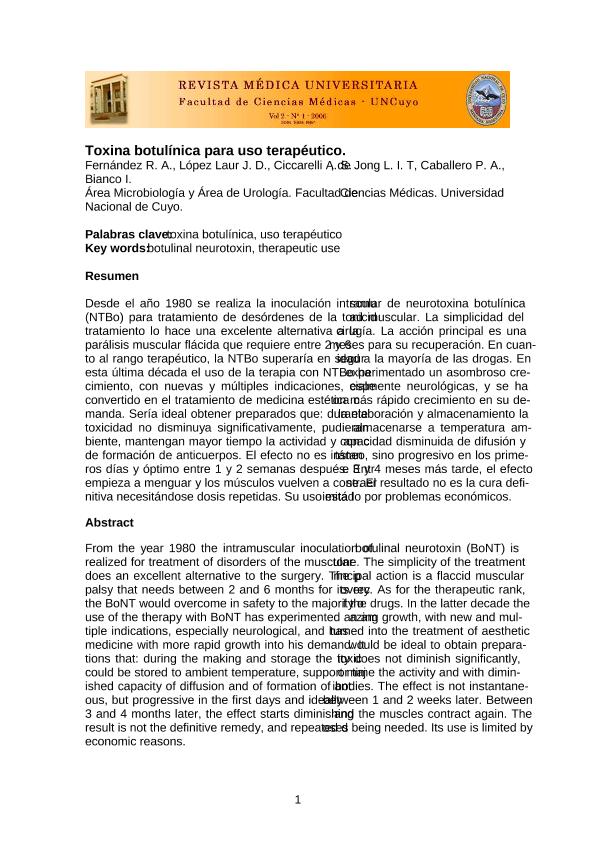Mostrar el registro sencillo del ítem
dc.contributor.author
Fernandez, Rafael Alfredo

dc.contributor.author
Lopez Laur, J.D.
dc.contributor.author
Ciccarelli, A.S.
dc.contributor.author
de Jong, L.I.T.
dc.contributor.author
Caballero, Patricia Alejandra

dc.contributor.author
Bianco, María Isabel

dc.date.available
2018-04-05T18:12:06Z
dc.date.issued
2006-12
dc.identifier.citation
Fernandez, Rafael Alfredo; Lopez Laur, J.D.; Ciccarelli, A.S.; de Jong, L.I.T.; Caballero, Patricia Alejandra; et al.; Toxina botulínica para uso terapéutico; Facultad de Ciencias Médicas. Universidad Nacional de Cuyo; Revista Médica Universitaria; 2; 1; 12-2006; 1-7
dc.identifier.issn
1669-8991
dc.identifier.uri
http://hdl.handle.net/11336/40939
dc.description.abstract
From the year 1980 the intramuscular inoculation of botulinal neurotoxin (BoNT) is realized for treatment of disorders of the muscular tone. The simplicity of the treatment does an excellent alternative to the surgery. The p rincipal action is a flaccid muscular palsy that needs between 2 and 6 months for its rec overy. As for the therapeutic rank, the BoNT would overcome in safety to the majority o f the drugs. In the latter decade the use of the therapy with BoNT has experimented an am azing growth, with new and mul- tiple indications, especially neurological, and has turned into the treatment of aesthetic medicine with more rapid growth into his demand. It would be ideal to obtain prepara- tions that: during the making and storage the toxic ity does not diminish significantly, could be stored to ambient temperature, support maj or time the activity and with dimin- ished capacity of diffusion and of formation of ant ibodies. The effect is not instantane- ous, but progressive in the first days and ideally between 1 and 2 weeks later. Between 3 and 4 months later, the effect starts diminishing and the muscles contract again. The result is not the definitive remedy, and repeated d oses being needed. Its use is limited by economic reasons.
dc.format
application/pdf
dc.language.iso
spa
dc.publisher
Facultad de Ciencias Médicas. Universidad Nacional de Cuyo
dc.rights
info:eu-repo/semantics/openAccess
dc.rights.uri
https://creativecommons.org/licenses/by-nc-sa/2.5/ar/
dc.subject.classification
Otras Ciencias Biológicas

dc.subject.classification
Ciencias Biológicas

dc.subject.classification
CIENCIAS NATURALES Y EXACTAS

dc.title
Toxina botulínica para uso terapéutico
dc.type
info:eu-repo/semantics/article
dc.type
info:ar-repo/semantics/artículo
dc.type
info:eu-repo/semantics/publishedVersion
dc.date.updated
2018-03-15T15:21:54Z
dc.journal.volume
2
dc.journal.number
1
dc.journal.pagination
1-7
dc.journal.pais
Argentina
dc.journal.ciudad
Mendoza
dc.description.fil
Fil: Fernandez, Rafael Alfredo. Universidad Nacional de Cuyo; Argentina
dc.description.fil
Fil: Lopez Laur, J.D.. Universidad Nacional de Cuyo; Argentina
dc.description.fil
Fil: Ciccarelli, A.S.. Universidad Nacional de Cuyo; Argentina
dc.description.fil
Fil: de Jong, L.I.T.. Universidad Nacional de Cuyo; Argentina
dc.description.fil
Fil: Caballero, Patricia Alejandra. Universidad Nacional de Cuyo; Argentina
dc.description.fil
Fil: Bianco, María Isabel. Consejo Nacional de Investigaciones Científicas y Técnicas. Oficina de Coordinación Administrativa Parque Centenario. Instituto de Investigaciones Bioquímicas de Buenos Aires. Fundación Instituto Leloir. Instituto de Investigaciones Bioquímicas de Buenos Aires; Argentina. Consejo Nacional de Investigaciones Científicas y Técnicas. Oficina de Coordinación Administrativa Parque Centenario. Instituto de Ciencia y Tecnología ; Argentina
dc.journal.title
Revista Médica Universitaria
dc.relation.alternativeid
info:eu-repo/semantics/altIdentifier/url/http://revista.medicina.edu.ar/
Archivos asociados
